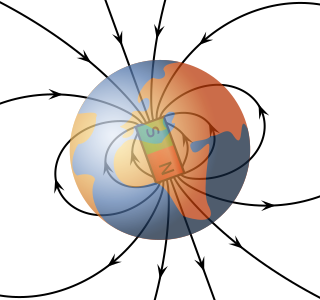
Plus Advent Calendar Door #21: Mysterious magnetism
The Earth has a magnetic field and that's why the needle of a compass always points North. People have been using compasses to find their way around for over 2000 years, but we still don't know where the Earth's magnetic field comes from and how exactly it behaves.
"It's unbelievable that people are living on the Earth and not understanding why the compass needle points North," says Emmanuel Dormy, a mathematician who is currently co-organising a research programme about the topic at the Isaac Newton Institute for Mathematical Sciences (INI) in Cambridge. Only the most cutting edge of maths and science questions get discussed at the INI — which goes to show just how mysterious the Earth's magnetism still is.
As a very crude approximation, the Earth's magnetic field is like that of the familiar bar magnet, which has poles at either end and generates magnetic field lines all around it.

As a crude approximation the Earth's magnetic field looks like that of a bar magnet. Figure: Mike Run, CC BY-SA 3.0.
The details of the Earth's field, though, are a lot more complex. Scientists think that it is generated by electrical currents running through the liquid, molten iron that forms the outer layer of the Earth's core. As we saw behind yesterday's door, the Earth behaves like a massive dynamo, not unlike the dynamos that power bicycle lights (you can find out more in this article). But because the liquid in the Earth's outer core is continually sloshing about, the Earth's magnetic field displays tangles a simple bar magnet can't rival, and it also changes over time — it can even flip, reversing its North and South magnetic poles. The details of what's going on, and the theory explaining the dynamo process, are far from understood.

Computer simulation of the Earth's field. The lines represent magnetic field lines, blue when the field points towards the center and yellow when away. The dense clusters of lines are within Earth's core. Image courtesy NASA.
The Earth isn't the only body that behaves like a dynamo. Other planets in our solar system have magnetic fields too, as does the Sun and other stars further afield. The magnetic field of our Sun determines the space weather our own planet experiences — this includes beautiful phenomena like the Northern and Southern lights, but also things like solar flares, which can be dangerous for Earth-made technologies.
These applications are still rather speculative, but magnetic fields are interesting for other reasons too. "Magnetic fields come from deep inside the planets," explains Christopher Jones, another co-organiser of the INI programme. "By studying those magnetic fields we can hope to learn a bit more about what's actually going on inside the planets, and inside the Earth, in a way that is very difficult when you can only just look at the surface."
Excitingly, there's even a role for aliens in this story. Because the magnetic field of a star determines some of the conditions on the planets that are orbiting around it, magnetic fields could one day help us with our search for life elsewhere in the Universe.
Click here to continue reading this article.
Return to the Plus advent calendar 2022.
This article was produced as part of our collaboration with the Isaac Newton Institute for Mathematical Sciences (INI) – you can find all the content from the collaboration here.
The INI is an international research centre and our neighbour here on the University of Cambridge's maths campus. It attracts leading mathematical scientists from all over the world, and is open to all. Visit www.newton.ac.uk to find out more.
